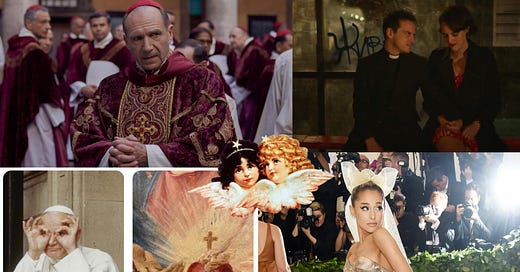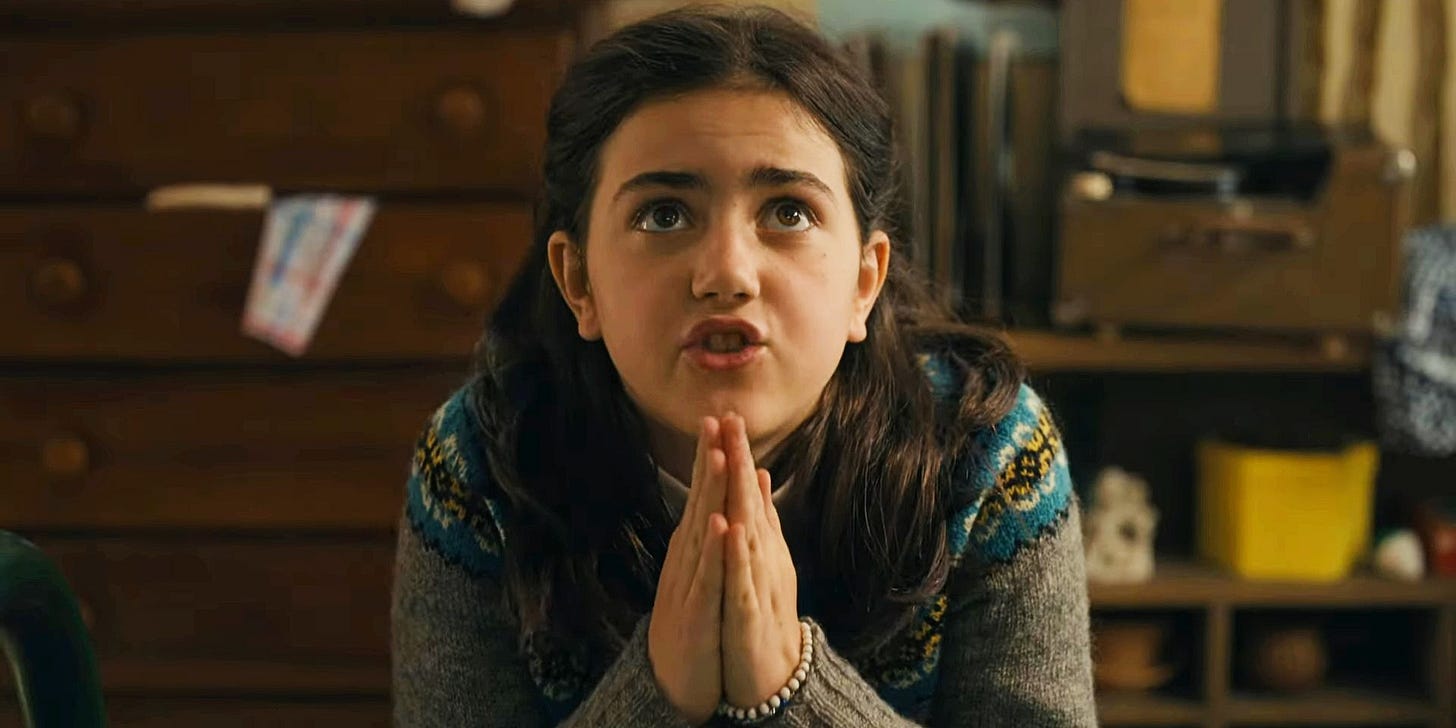The Aesthetic of Restraint & Release
Pop Culture Catholic Revival and Digressions on Surrender
The joke goes that Americans don’t have culture. Even less so if you’re a white person. And even less so, I’d posit, if you’re a white person from the Pacific Northwest. Of course, all of this is relative. North America is rich with historical significance, natural wonder, and cultural distinctiveness. It’s just that much of the history that we consider to be “American” - as in, of the stars-and-stripes variety - started after indigenous genocide, less than 300 years ago. Practically yesterday, in the grand scheme of recorded human civilizations. A smudge on the timeline.
The American Pacific Northwest, where I’m from, is even “newer” than that, by about a hundred years. My great-grandparents immigrated from Holland and Sweden in the early twentieth century and left most of their European traditions with them. Or perhaps there was some kind of wrinkle in my ancestral line. On Heritage Day in elementary school, we had to adorn a paper stick figure with emblems of our cultural heritage - clothing, food, musical instruments, etc. I was stumped trying to figure out what I should draw, watching my classmates doodle cuisine and clothing from Taiwan, India, Mexico, and so on. My dad said to draw a Mariners hat on my stick figure’s head and a salmon in her hand - we were a family of Seattleites through and through.
And in true Seattleite fashion, we weren’t particularly religious. We weren’t of the hyper-granola, laissez-faire variety. I wasn’t encouraged to “discover my own religion” or “find God in myself” like a parent in Portlandia might suggest. Our footing in Christianity was rooted less in tradition and more in light sentiment - the thought that going to church is probably good for young kids. A nice-to-have.
We attended a Presbyterian church that was, frankly, as secular as they come. I went to a Christian preschool. I attended Vacation Bible School in the summers, which involved craft time, snack time, recess, and singing vaguely Christian rock music with a live band. At night, we watched VeggieTales while lying on pillows on our stomachs, munching popcorn.
It was all light, no weighty feelings. “Church” was a source of summer camp joy, not fear-mongering. The only kind of baptism I underwent was a pinky promise to my VBS leader that Jesus was my best friend while we wove plastic lanyards. All play and no work made it harder to integrate Christian sentiments into my everyday life - it was hard for me to see where to place these “lessons” outside of singing and crafting about them. Jesus was like Mickey Mouse to me.
One day, my mom picked me up from Sunday school, and I showed her a coloring page I completed of all the bugs and insects God had made - butterflies, ladybugs, dragonflies, and so on. In the middle of discussing it with her, a bee flew into the car, buzzing against the windshield. My mom grabbed the coloring page, rolled it up, and began violently swatting, trying to kill it or get it out of the car, summing up secular Seattle Presbyterianism in one swift action.
I developed my own kind of clumsy nightly prayer, which was phrased inelegantly and involved me simply asking for things. Very Are You There God? It’s Me Margaret (1970). I asked God to help me ace my tests, to nail my Nutcracker audition, and to grant mercy to my friends and family - protect them from diseases and landslides and car crashes. When I was overwhelmed by school, friendships, and existentialism, I asked my mom what to do. “Surrender it to God,” she would say abstractly. “Put it in His hands, let Him handle it.”
Naturally, many kids grow curious about the business of religion and God as they grow older, and take science and liberal arts courses. They begin to recognize the conservative beliefs that often coincide with rigid Christianity. They witness Jesus-loving people in their family use their church attendance as an ego booster, a means to separate themselves hierarchically, and even excuse poor behavior. As kids get more involved in extracurricular activities and as their parents’ marital bonds dissolve, church slides to a lower rung on their growing ladder of priorities. At least in my case.
Barack Obama served as president between my eighth and fifteenth years, ages when beliefs about morality are crystallizing. In 2015, same-sex marriage was legalized nationwide. Around then, the Westboro Baptist Church also came into my view. The WBC had developed a reputation for picketing outside the funerals of victims of anti-gay attacks. In 2009, they showed up outside the funeral service for Dr. George Tiller, who was assassinated in church by an anti-abortion extremist. They threatened to picket at the funerals of Sandy Hook victims. WBC imitators - picketers espousing that “homosexuality is a sin” - began popping up outside my high school and downtown during concerts and sporting events.
As such, in the 2010s, being a Jesus hater was fashionable among my teenage friends on and offline, especially in the aftermath of a spotlight being shone on the Catholic Church’s sex abuse scandals in the U.S, just a decade prior. Being an ally to my queer friends meant turning my nose up against Christianity. My budding moral constitution comprised of “either/or” - no room for “and.” And, as it always has, taking a stance against Christianity felt subversive, intelligent, and bad. Ashing your cigarette on a pew. Being blasé in the face of your imminent burning in hell - was there anything cooler?
And then, as it always has, what was once subversive became common. Being an uninformed hater became lowly. Proximity to culture and worldliness became chic, and this necessitated a proximity to Catholicism, albeit a surface-level one, in many cases. I’d dub the 2018 Met Gala a point of transition - at least, online. The theme: “Heavenly Bodies: Fashion and the Catholic Imagination.” Rihanna took to the carpet in a papal-inspired Galliano look, Ariana Grande had the Sistine Chapel ceiling painted on her Vera Wang gown, and Zendaya donned Joan of Arc armor. The high fashion girls of Twitter played art historians, drawing parallels between Lana Del Rey’s Gucci ensemble and Our Lady of the Seven Sorrows.
On the Met Gala’s heels, the aesthetic of Catholicism found its way onto It Girl moodboards. Images of rosaries, stained glass, and Ladybird (2017) circulated on Pinterest. Everyone and their mother owned a baby-tee featuring the Fiorucci cherubs. Bodysuits with Michelangelo prints. Season two of Fleabag shattered viewers in 2019, weaving themes of lust, restraint, and guilt into a love story between the titular character and Andrew Scott as a hot priest. Being connected to God was cool again. It began ironically and now, like all slow-moving pendulums, is perhaps inching toward a more sincere place.
In her essay “how I found feminism in Hindu tradition,” writer Aishwarya Vardhana writes about the complexity of including Hindu traditions in her wedding, specifically traditions that have symbolized upholding patriarchal family structures. “This feminist craves pomp and circumstance,” she writes, describing how various aspects of a pooja - the smell of incense, the Sanskrit chanting, the shirtless priest sitting around a holy fire - evoke “a feeling of splendor and Indianness” that would otherwise feel absent from a Hindu wedding.
This perspective reminds me of how I felt when I first saw St. Paul’s Cathedral in London, at age eighteen. It was the first time I felt moved to tears by a physical structure. The gilded ceilings, the polished floors, and candelabras illuminating the cavernous hall. The church I had grown up going to was beautiful - panes of stained glass, music from an organ, handheld candles during “Silent Night” - but it didn’t evoke the feeling of splendor that this one did. I couldn’t believe that a group of people cared so much about something, had such strong convictions, that they would build something this grand.
The Catholic Church, of course, has long been criticized for its exuberance. Yet, I think many of us crave the pomp and circumstance - the grandeur - associated with religion, particularly those who are alienated from ritual in our day-to-day lives. Hence, the internet stirring around Pope Francis’ death and Leo XIV’s recent election - the most ironic people I know online rejoicing at the election of the first North American pope. I think it’s similarly the reason why Gen Z have lauded Conclave (2024), drawing parallels between the grand ritual of pope selection and the more relatable ritual of gossip and scandal.
Along with being fascinated by Catholicism’s visual script, I’ve lately been curious about people who are willing to put their faith wholeheartedly into something. That are comfortable with “surrendering,” as my mom once suggested to me. In my own life, I’ve cultivated my own version of “surrender,” but have only seen it manifest in glimpses. In the wings of a theatre, in my bed with my eyes and ears tightly shut, when the plane hits an air pocket. Who or what I’m surrendering to, in any given moment, is always a bit hazy. God, karma, probability, physics. It’s easy to surrender in moments of exhilaration and fear - in my day-to-day life, I keep a tight leash on control, suffocating its neck with my grip. Releasing doesn’t come naturally. I’ve been curious about going to a service, sitting in the pews, and watching the attendees, a fish among its school. How do they do it? I’d wonder. How do they release it?
As usual, I think magic lies in the in-between - in the halfway point between having control and giving it up. Similarly, Aishwarya writes beautifully about filling the cracks in the foundation of Hindu traditions that are, at times, troubling. “I had no qualms with our pooja because it existed in the broader context of myself and my husband, and in our context I have agency,” she writes about her wedding. The cracks are what interest me most too.
We’re all, it seems, trying to place our faith into something - be it romance, religion, career, and even standom. Whether or not we admit it, I think we’re eager to have something or someone to rely on, which makes the monikers of faith - the grand cathedrals, the hands thrust to the sky, the tears landing on rosaries - all the more romantic.
Maybe, secretly, young people’s draw to the aesthetics of religion is also a draw to the horseshoe aesthetics of control and surrender. Restraint and release. We’re compelled to glance at the blueprints. Conclave’s thesis suggests that those who teeter between full restraint and full release - who exist in this greyer space - perhaps embody “faith” most fully. “Our faith is a living thing precisely because it walks hand-in-hand with doubt,” Cardinal Lawrence says to his peers, pre-pope selection. “If there was only certainty and no doubt, there would be no mystery.” The romance perhaps lies in that mystery too.










This really hit the spot for me, especially as a PNW kid raised Catholic haha. So much of the image of Catholicism is one of aesthetic maximalism: massive cathedrals, stories-tall stained glass, long drawn-out prayers and masses, incense, etc., and I think a huge part of that has to do with the church wanting to affect how an individual sees their place within the church. Lots of protestant churches in the US are sort of sparse looking, and I think the point of that choice is to draw the individual away from the splendor and towards oneself. A lot of these denominations prioritize an individual relationship with God, whereas with Catholicism the individual relationship is not the point.
In Catholicism you're supposed to feel like a small part of a larger thing, where the individual is really not the most important thing. You're supposed to be humbled by the splendor of the church. It's a perspective that's kind of at odds with the hyper individualism of the US, so it's interesting to see how celebrities and some Americans try to grab onto Catholicism as an individual expression when that's quite literally not the point!
I nodded the entire time I read this. I think the current fascination with religion also stems from a need for real (offline) community and need for structure and even leadership. I've always been fascinated by religion, but still resist the institutions surrounding it.